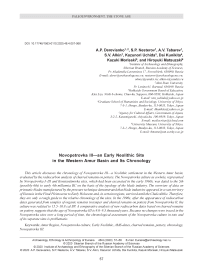Novopetrovka III-an early neolithic site in the Western Amur basin and its chronology
Автор: Derevianko A.P., Nesterov S.P., Tabarev A.V., Alkin S.V., Uchida K., Kunikita D., Morisaki K., Matsuzaki H.
Журнал: Archaeology, Ethnology & Anthropology of Eurasia @journal-aeae-en
Рубрика: Paleoenvironment, the stone age
Статья в выпуске: 4 т.48, 2020 года.
Бесплатный доступ
This article discusses the chronology of Novopetrovka III—a Neolithic settlement in the Western Amur basin, evaluated by the radiocarbon analysis of charred remains on pottery. The Novopetrovka culture as a whole, represented by Novopetrovka I–III and Konstantinovka sites, which had been excavated in the early 1960s, was dated to the 5th (possibly 6th) to early 4th millennia BC on the basis of the typology of the blade industry. The overview of data on prismatic blades manufactured by the pressure technique demonstrated that blade industries appeared in a vast territory of Eurasia in the Final Pleistocene to Early Holocene and, in certain regions, survived until the Chalcolithic. Therefore, they are only a rough guide to the relative chronology of the sites. In the 1990s, after the appearance of radiocarbon dates generated from samples of organic remains in temper and charred remains on pottery from Novopetrovka II, the culture was redated to 15.5–10.8 cal BP. A comparative analysis of new radiocarbon dates based on charred remains on pottery suggests that the age of Novopetrovka III is 9.0–9.5 thousand years. Because no changes were traced in the Novopetrovka sites over a long period of time, the chronological assessment of the Novopetrovka culture in toto and of its separate sites is problematic.
Amur Region, Novopetrovka culture, Early Neolithic, AMS-dates, charred remains, pottery, chronology, Novopetrovka III
Короткий адрес: https://sciup.org/145146041
IDR: 145146041 | DOI: 10.17746/1563-0110.2020.48.4.057-066


